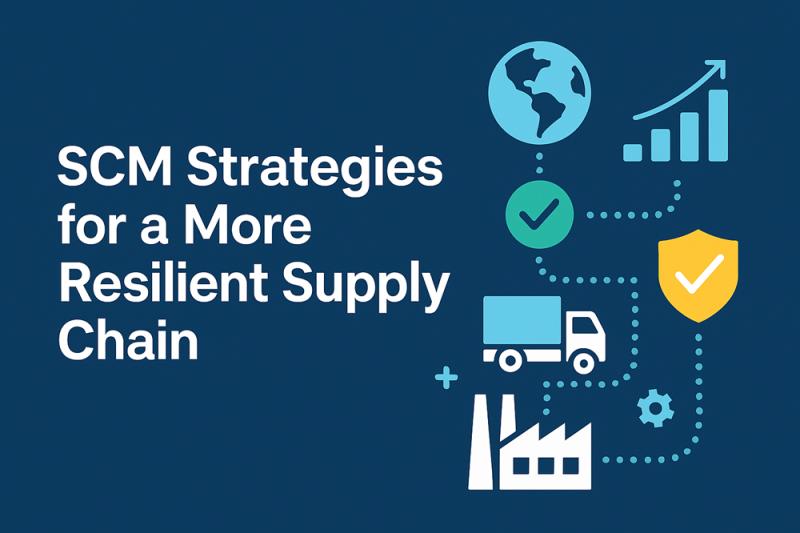SCM Strategies for a More Resilient Supply Chain

Introduction
The world of business is unpredictable, and supply chain disruptions have become more frequent due to factors like geopolitical instability, natural disasters, and economic fluctuations. This is where SCM (Supply Chain Management) steps in to create a buffer against uncertainties. A well-structured SCM strategy ensures that businesses can continue their operations even when the unexpected happens. But how exactly can SCM help build a more resilient supply chain? Let’s explore.
Build a stronger, more resilient supply chain with AI-powered strategies: https://thousense.ai/pricing
Understanding Resilience in Supply Chain Management
Resilience in SCM refers to the ability of a supply chain to adapt to unexpected disruptions while maintaining efficiency. It’s not just about bouncing back but also about proactively preparing for risks before they happen. Several factors influence the resilience of a supply chain, such as flexibility, technology adoption, risk management strategies, and collaboration between different stakeholders.
A resilient SCM system ensures continuity by mitigating potential risks and providing alternative pathways to keep goods and services moving. The goal is to develop an adaptive system that can recover quickly without significant losses or delays.
Key SCM Strategies for a Resilient Supply Chain
Building a resilient supply chain is not an overnight process. Businesses need to adopt smart SCM strategies that enhance flexibility, transparency, and adaptability. Below are some critical strategies that strengthen supply chains.
Diversification of Suppliers and Logistics
Relying on a single supplier or logistics provider can be risky. If one supplier faces a shutdown, your entire supply chain could collapse. To enhance resilience, businesses should diversify their sourcing strategies. This involves working with multiple suppliers across different geographical regions to reduce dependency on any single entity.
Moreover, adopting multiple logistics providers and transportation routes ensures that deliveries are not halted due to regional disruptions. A flexible SCM approach includes evaluating alternative transport modes like rail, air, and sea to keep the supply chain running smoothly.
Technology Integration for Real-time Visibility
One of the most transformative aspects of modern SCM is technology integration. Real-time data visibility through IoT (Internet of Things), blockchain, and AI-driven analytics allows businesses to monitor their supply chain in real time.
For instance, predictive analytics in SCM can identify potential risks before they escalate, helping companies make proactive decisions. Blockchain technology enhances transparency by providing tamper-proof tracking of goods throughout the supply chain, reducing fraud and inefficiencies.
Agile Inventory Management
An effective SCM strategy involves maintaining an optimal balance between supply and demand. Businesses must decide between just-in-time (JIT) inventory models and maintaining safety stock to handle unexpected disruptions.
JIT minimizes waste and storage costs but can leave businesses vulnerable to supply shocks. On the other hand, maintaining a safety stock ensures continuous operations even when delays occur. A hybrid approach, blending both models based on demand forecasting, is often the best SCM solution.
Risk Assessment and Contingency Planning
Proactive risk assessment is essential for a resilient SCM system. Businesses should identify potential vulnerabilities in their supply chains and develop contingency plans accordingly.
For instance, if a key supplier shuts down, having pre-approved alternative suppliers can ensure smooth operations. Developing response plans for potential risks, such as cyber-attacks, transportation delays, or raw material shortages, is an integral part of SCM resilience.
Collaboration and Stronger Partnerships
A strong SCM framework is built on collaboration. Companies that maintain healthy relationships with suppliers, manufacturers, and logistics providers are better equipped to handle crises.
Transparent communication and coordinated efforts across different departments, including procurement, logistics, and sales, ensure a streamlined approach to supply chain resilience. Collaborative planning tools and cloud-based SCM platforms help organizations work in sync, even during disruptions.
The Role of Digital Transformation in SCM Resilience
The rapid digitalization of SCM is a game-changer in enhancing supply chain resilience. Automation, AI, and cloud-based tools enable businesses to operate more efficiently while minimizing human errors.
For example, AI-driven demand forecasting helps companies prepare for fluctuations by analyzing historical data and market trends. Cloud-based SCM platforms allow businesses to access critical supply chain information from anywhere, facilitating better decision-making in real time.
E-commerce giants and manufacturing leaders are already leveraging automation to streamline order fulfillment, inventory management, and logistics. Companies that adopt these technologies are in a better position to handle disruptions and maintain smooth operations.
Conclusion
A resilient supply chain is not just a luxury—it’s a necessity in today’s unpredictable world. Businesses that invest in robust SCM strategies, such as supplier diversification, real-time technology integration, and agile inventory management, can navigate uncertainties with confidence. Digital transformation further strengthens SCM, ensuring long-term sustainability. By prioritizing adaptability and collaboration, businesses can future-proof their supply chains and stay competitive, no matter what challenges arise.
FAQs
- How does SCM contribute to supply chain resilience?
SCM enhances resilience by optimizing supplier relationships, improving inventory management, and integrating technology for real-time decision-making. - What is the biggest challenge in making a supply chain more resilient?
The biggest challenge is balancing cost efficiency with resilience. Many businesses prioritize cost-cutting over preparedness, making them vulnerable to disruptions. - How can small businesses improve their SCM strategies?
Small businesses can enhance their SCM by adopting cloud-based platforms, diversifying suppliers, and leveraging third-party logistics providers for better flexibility. - Why is supplier diversification crucial in SCM?
Relying on a single supplier increases the risk of disruptions. Diversification ensures that businesses have backup sources in case of supply chain failures. - What role does technology play in strengthening SCM?
Technology enhances visibility, automates processes, and improves predictive analytics, making supply chains more efficient and less prone to disruptions.
Post Your Ad Here
Comments